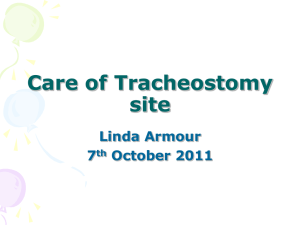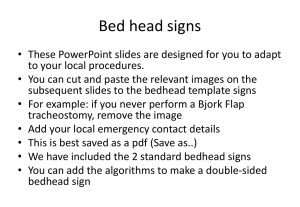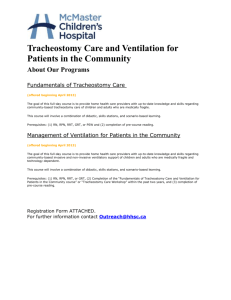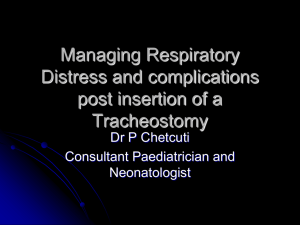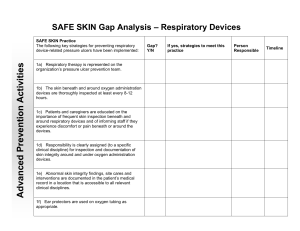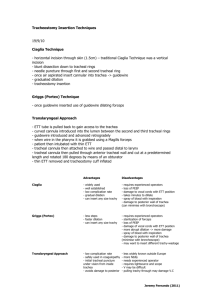Simulation scenario testing for the management of critical airway
advertisement
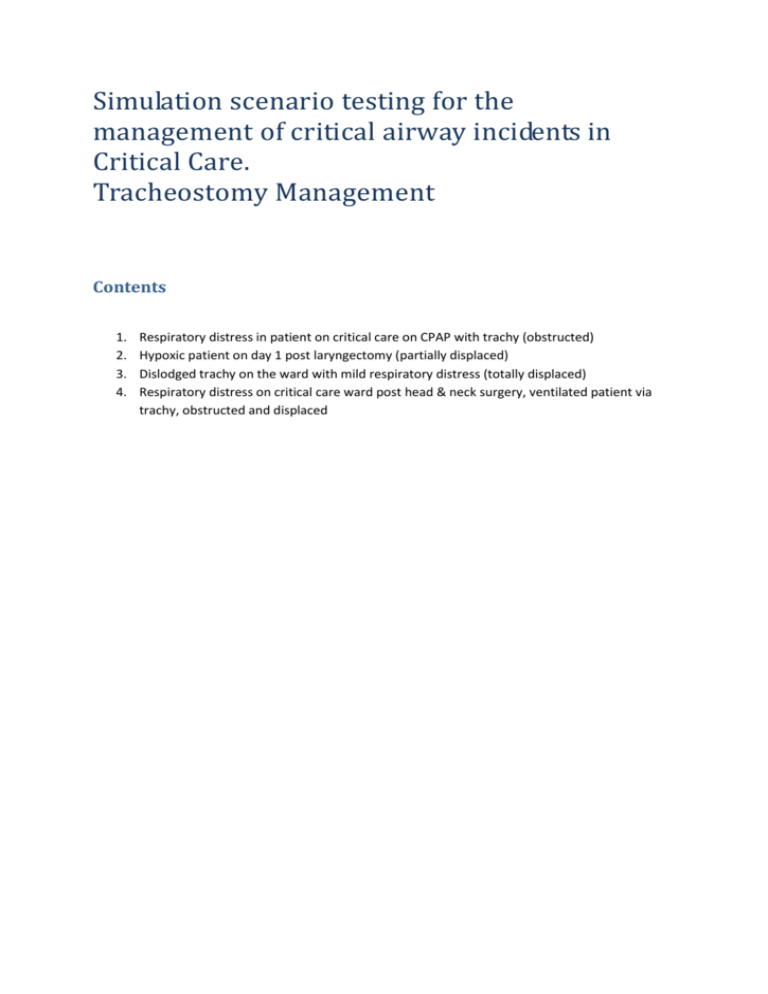
Simulation scenario testing for the management of critical airway incidents in Critical Care. Tracheostomy Management Contents 1. 2. 3. 4. Respiratory distress in patient on critical care on CPAP with trachy (obstructed) Hypoxic patient on day 1 post laryngectomy (partially displaced) Dislodged trachy on the ward with mild respiratory distress (totally displaced) Respiratory distress on critical care ward post head & neck surgery, ventilated patient via trachy, obstructed and displaced Scenario 1 Respiratory distress in patient on critical care on CPAP with trachy (obstructed) Scenario You are on the ITU and are called to see a 60 year old man who has been on the ITU for 2 weeks and is recovering from an infective exacerbation of COPD. He required mechanical ventilation for 6 days and after a failed extubation, he had a percutaneous tracheostomy performed 6 days ago. He has a single lumen cuffed tracheostomy in situ which has not been changed. He has been weaning steadily and was breathing spontaneously on a CPAP circuit with 5 cm H2O CPAP and 40% O2, at 30 l/min flow. HR is 120/min and Resp rate 45/min with obvious use of the accessory muscles of respiration. His SpO2 is 86%. There is no vocalisation. Manikin Critical Care Environment Partially obstructed trachy in situ (can we make or fake this?) HR 120, BP 160/100 RR 45, ventilating through trachy spontaneously, SpO2 86% Kit List CPAP Circuit – elephant tubing with trachy connector +/- CPAP valve Spare NRB Mask with green oxygen tubing Bougie Spare trachy tube Intubation equipment including ETT and LMA and bougie Waters’ circuit Fibre-optic scope Suction catheters to fit down trachy Bed head trachy sign and algorithm What are you going to do? Section 1 – Assessing the patency of the tracheostomy Expect an ABC approach 1.1 Decide at outset that this is a trachy patient with a potentially patent upper airway. Follow the patent upper airway algorithm. 1.2 Call for help (Anaesthetics / Critical Care senior help AND ENT / Max Fax) 1.3 Administer 100% O2 to the face via new facemask 1.4 AND 100% O2 to the tracheostomy initially by turning up the FI O2 of the CPAP circuit, or by attaching a Waters’ circuit (Don’t argue about hypoxic drive!) 1.5 Check that the trachy cuff is inflated (it is) 1.6 Is the patient breathing spontaneously? Minimal ventilation. Bag doesn’t move (if Waters’ circuit attached). No mouth breathing. This should take candidate down the ‘obstructed’ trachy route. If they are unsure, then stop the manikin breathing – respiratory arrest. Assess clinically (listen or feel) minimal breath heard / felt (set to none on manikin?) or attach a Waters’ circuit and look for spontaneous breathing Bag doesn’t move ask for Capnography this is not attached initially, but can be set up if requested 1.7 Check patency of tracheostomy with suction catheter. Suction catheter will not pass 1.8 Remove, unblock and replace the inner tube – there is no inner tube If they ask... Is there any mouth breathing? No Look for subcutaneous emphysema. None Check for obvious displacement, blood or secretions. Not obviously displaced Exclude a speaking valve. None present Is there an inner tube? No 1.9 Deflate the trachy tube cuff. Reassess mouth and trachy breathing. No breathing detected at mouth or trachy. Section 2 – Removal of tracheostomy and emergency oxygenation Clinical course The patient continues to deteriorate with SpO2 75% on 100% O2. Manikn becomes apnoeic and unresponsive. Make manikin unable to be ventilated and stop breathing 2.1 Remove the blocked tracheostomy. Reassess ventilation via stoma and mouth If the candidate doesn’t remove the trachy, progress to severe bradycardia (as a hint!) then asystolic cardiac arrest. (Will have to follow 2 mins CPR 30:2 with 1mg Adrenaline bolus, then address the airway. Continue with arrest until trachy taken out) 2.2 Simple bag and mask with guedel. No ventilation. SpO2 drop to 70%. HR starts to fall to 80 bpm 2.3 Insertion of LMA as rescue device. No ventilation. SpO2 still 70%. HR falls to 50 bpm 2.4 Oral intubation. This should be made easy. Manikin should become able to be ventilated but remain apnoeic Need an uncut tube beyond the stoma or to keep occluding the stoma otherwise ventilation will fail. Ventilation is possible and SpO2 starts to improve to 90%, HR up to 110 bpm, BP 180/110 mmHg 2.5 Stoma intubation may be attempted if the oral intubation fails or the candidate doesn’t attempt intubation at all. Re-insertion of a new trachy tube or a small ETT results in successful ventilation and improvement as above. 2.6 Tracheal stoma ventilation (small facemask, LMA or intubation) may be attempted if failed upper airway management. This results in SpO2 staying only at 80% as a definitive attempt at securing the airway is required. Section 3 – Stabilisation and further management Clinical course The patient starts to breathe spontaneously again through the ETT. SpO2 94%, HR 110 bpm, BP 150/100 mmHg. 3.1 Need expert help to sedate and ventilate 3.2 Need to formally redo the trachy as it is a 6 day old perc. If skills (and time) allow then attempted re-insertion of trachy over suction catheter, bougie or fibre-optic scope are all acceptable. This results in stable vital signs as above and successful ventilation spontaneously via the tracheostomy. Section 4 - Further discussion Sedate and ventilate or trial of decanulation. Depends on how far off he was prior to this critical incident. If decanulation was not imminent, probably best to ventilate. Will need the percutaneous tracheostomy re-fashioning with the aid of a bronchoscope What measures could we use to try and stop this tracheostomy from occluding in the first place? Regular suction by healthcare staff competent to look after the tracheostomy Use of humidification Use of a double lumen tracheostomy with a cleanable inner tube What are the pro’s and con’s of a double cannula tube? Pro’s Able to remove inner tube and clean easily. Much less likely to obstruct Can use fenestrated tubes with fenestrated inners to allow vocalisation Con’s Smaller internal diameter can increase breathing resistance compared to a similar external diameter single lumen tube Often need an inner tube (which may have been misplaced) to connect to a breathing circuit in an emergency Still need replacing after 30 days (10-14 days for simple single lumen tracheostomies) Increased potential for error when using different inner cannulae with breathing circuits. Eg fenestrated inner tube with CPAP Scenario 2 Hypoxic patient on day 1 post laryngectomy (partially displaced) Scenario You are called to see a 58 year old man on the High Dependency Unit who is day 1 post total laryngectomy. There was some bleeding from the stoma at the end of the operation so he had a double-cannula tracheostomy tube inserted into the stoma. There is a sign attached to his bed head stating that he has had a total laryngectomy. He had been doing well and was awake, breathing spontaneously on 40% humidified oxygen via a trachy mask. He started to cough and quickly became distressed and looks blue. The nursing staff ask to you come quickly. Manikin Critical Care Environment Partially obstructed trachy in situ (can we make or fake this?) HR 120, BP 110/55 RR 30, ventilating through trachy spontaneously, SpO2 82% Kit List Trachy Mask Spare NRB Mask with green oxygen tubing Bougie Spare trachy tube Intubation equipment including ETT and LMA and bougie Waters’ circuit Fibre-optic scope Suction catheters to fit down trachy Bed head trachy sign and algorithm What are you going to do? Section 1 – Assessing the patency of the tracheostomy Expect an ABC approach 1.1 Decide at outset that this is a laryngectomy patient with no upper airway. Follow the laryngectomy algorithm. 1.2 Call for help (Anaesthetics / Critical Care senior help AND ENT / Max Fax) 1.3 Administer 100% O2 to the face via new facemask (This is a default emergency action. Acceptable for a candidate to state that face oxygen is not required as there has been a laryngectomy.) 1.4 AND 100% O2 to the tracheostomy initially by turning up the FI O2 of the humidified circuit, or by attaching a Waters’ circuit 1.5 Check that the trachy cuff is inflated (it is) 1.6 Is the patient breathing spontaneously? Minimal ventilation. Bag doesn’t move (if Waters’ circuit attached). No mouth breathing! This should take candidate down the ‘obstructed’ trachy route. If they are unsure, then stop the manikin breathing – respiratory arrest. Assess clinically (listen or feel) minimal breath heard / felt at stoma (set to none on manikin?) or attach a Waters’ circuit and look for spontaneous breathing Bag doesn’t move ask for Capnography this is not attached initially, but can be set up if requested 1.7 Check patency of tracheostomy with suction catheter. Suction catheter will not pass 1.8 Remove, unblock and replace the inner tube – there is no inner tube If they ask... Is there any mouth breathing? No Look for subcutaneous emphysema. None Check for obvious displacement, blood or secretions. Not obviously displaced Exclude a speaking valve. None present Is there an inner tube? No Section 2 – Removal of tracheostomy and emergency oxygenation The candidate should work out that the tube is blocked or partially displaced and must be removed before moving on. The next essential step is to realise that conventional oral airway management has no place in this patient and concentrate on the tracheostomy. Clinical course The patient continues to deteriorate with SpO2 75% on 100% O2. Manikin becomes apnoeic and unresponsive. Make manikin unable to be ventilated and stop breathing 2.1 Remove the blocked tracheostomy. Reassess ventilation via stoma If the candidate doesn’t remove the trachy, progress to severe bradycardia (as a hint!) then asystolic cardiac arrest. (Will have to follow 2 mins CPR 30:2 with 1mg Adrenaline bolus, then address the airway. Continue with arrest until trachy taken out) The SpO2 is too low for them to mess about with fibre-optic scopes etc. If they do, follow the above hypoxic arrest situation 2.2 No ventilation. Move to emergency oxygenation 2.3 Apply Small Face mask to stoma (try paediatric mask or LMA) Are they breathing spontaneously? Can you ventilate adequately? No ventilation spontaneously. Bagging via the stoma is not effective. SpO2 fall to 70% Try and support ventilation by ‘bagging’. You cannot ventilate adequately 2.4 Attempt intubation of stoma. Use 6.0 cuffed endotracheal tube or similar Intubation is successful. Candidate may choose a small ETT or laryngectomy tube. Ideally railroaded over suction catheter, bougie, Aintree catheter or FO scope. Manikin becomes able to be ventilated again. SpO2 gradually improve to 90% If they don’t intubate the stoma, there is no ventilation and a hypoxic arrest ensues. Section 3 – Stabilisation and further management Clinical course The patient starts to breathe spontaneously again through the ETT. SpO2 91%, HR 120 bpm, BP 90/50 mmHg. 3.1 Need expert help to sedate and ventilate 3.2 Transfer to ITU 3.3 ENT need to review 3.4 If time allows, Continue to assess the critically ill patient. B Auscultate the chest for bilateral air entry. Check SpO2 Clinical evidence of a pneumothorax? No Wheeze or crepitations? May be LVF or bronchospasm. No added sounds C Ensure IV access. Present Assess capillary refill and BP (4 secs centrally and 90/50 mmHg) D AVPU – unconscious E Nil else obvious on exposure Further discussion *Some double cannula tubes need the inner tubes inserted so you can attach a breathing circuit to them. Ensure they understand the different management of patients without a larynx Scenario 3 Dislodged trachy on the ward with mild respiratory distress (totally displaced) You are called urgently to a medical ward to see a 70 year old woman. She was admitted to ITU 3 weeks ago with LVF and pneumonia and was ventilated for 10 days. She had a surgical tracheostomy performed to aid in weaning due to her co-morbidities and her significant obesity and she was noted to be difficult intubation. A percutaneous tracheostomy was not felt to be safe to undertake. On your arrival she is sweaty and distressed and is pulling at the trachy mask around her neck. What are you going to do? ABC approach Call for help (ENT or Max Fax & Anaesthetics if appropriate) Administer 100% O2 to the face and the tracheostomy Attach a Waters’ circuit to the tracheostomy and look for spontaneous breathing The bag of the waters’ circuit attached to the trachy doesn’t move. A Check patency of tracheostomy – suction catheter is simplest Is there any mouth breathing? There seems to be inspiratory noises Look for subcutaneous emphysema. None Look at the capnography trace, or arrange to get a capnograph set up Check for obvious displacement, blood or secretions. Not obviously displaced Check the cuff inflates prn. Cuff appears up Exclude a speaking valve. None present Is there an inner tube? Yes. Remove, unblock and replace inner tube. Reassess breathing. There is still no tracheostomy ventilation What are you going to do? Hypoxic, distressed patient with non-patent tracheostomy. Not improving with facemask oxygen, implying obstructed or inadequate upper airway or ventilator effort. Need to remove tracheostomy as likely to be displaced or blocked. Removal of the tracheostomy causes improvement – less noisy breathing and patient appears more comfortable (less use of accessory muscles etc). SpO2 improves to 90%. Need to cover the stoma. What next? Apply oxygen to face and stoma Assess rest of patient B Auscultate the chest for bilateral air entry. Measure SpO2 Very poor AE bilaterally, 80%. Bibasal crepitations Clinical evidence of a pneumothorax? No Wheeze or crepitations? May be LVF or bronchospasm. Some wheeze throughout Consider ordering a CXR if the patient’s condition is stable enough (pneumothorax). No time C D E Ensure IV access. Present Assess capillary refill and BP (3 secs centrally and 180/110 mmHg). Raised JVP. HR 110 Irreg AVPU – awake and trying to communicate Nil else obvious on exposure What else do we need to do? ECG CXR Bloods and ABG Treat for LVF if we think that’s the problem (probably is) What do we do about the tracheostomy? Decision on whether it is required or not. Depends on Cough and secretion management (need for airway toilet) Need to airway protection – eg reduced GCS, not a problem in this case Need for ventilator support or CPAP – none for last 3 days Swallowing assessment to some degree Clinical Progress The patient becomes increasingly short of breath whilst you are arranging a CXR and ECG. The SpO2 drops to 85% on 15l/min non-rebreathe facemask applied to the face. What are we going to do? Call for help – ENT / Max Fax / Anaesthetics / ‘Crash team’ if not present Assess ABCDE as above A – patent upper airway, tracheostomy is covered with gauze swabs B – shallow effort, widespread crackles C/W LVF. SpO2 78% on 15l/min as above C – Cool and shut down peripherally, BP 90 mmHg systolic, HR 100 irreg D – Responsive only to pain E – Nil else obvious Arrange the ususal supportive stuff for LVF Diuretics Nitrates (BP bit low) Inotropes CPAP – Discuss now or at end as appropriate* The patient stops breathing and becomes deeply cyanosed. There is still a cardiac output, 100 bpm, BP 70 systolic. Crash team here, managing the circulation, candidate asked to manage airway and ventilation. What are we going to do? Standard airway management (keep away from the trachy for now) Facemask & Bag-valve-mask system – no effective ventilation Guedel airway and LMA – still can’t ventilate and still cyanosed Attempt oral intubation – What tube? (uncut, advance beyond the stoma) - can’t see anything Expert anaesthetic help arrives and can just manage to bag the patient. SpO2 90%. The crash team think that CPAP would be a good idea. How could we facilitate this? Oral intubation with specialist equipment +/- drugs o Fibreoptic, ILMA etc Attempt intubation of the tracheal stoma o Use 6.0 cuffed endotracheal tube o Bougie / Aintree catheter o Fibre-optic laryngoscope Further discussion Application of facial CPAP in patients with a tracheostomy stoma o May work if stoma effectively covered o Likely to have a big leak Discussion about intubating orally with an uncut tube beyond the stoma to ‘seal’ it. Potential problems of endobronchial intubation. How to re-insert a tracheostomy once the airway is secured, ie a controlled situation. o Surgical trachy – more likely to have a defined track o Percutaneous trachy will be difficult to change within the first 7-10 days and should be avoided. This is due to the tissues being elastic and ‘springing’ back into position quickly. Need to be prepared to re-fashion the tracheostomy from scratch if necessary. o The longer you wait after removal of a trachy, the more difficult it will become to re-insert. Potential problems include o False passage o Subcutaneous placement with subsequent surgical emphysema o Mediastinal trauma, great vessels o The use of adjunct like Aintree catheters and fibreoptic scopes Scenario 4 Respiratory distress on critical care ward post head & neck surgery, ventilated patient via trachy, obstructed and displaced Scenario You are called urgently to see a 45 year old man who is 2 days post op from a major oral squamous cell carcinoma (SCC) resection and free flap repair. He had a surgical tracheostomy carried out perioperatively. He has a double cannula tracheostomy in situ. He is currently receiving assisted spontaneous ventilations (on Pressure Support Ventilation) with 60% inspired oxygen. There is a large amount of oedema of the face and neck. He is tachycardic and hypertensive, as well as tachypnoeic with evidence of accessory respiratory muscle use. His SpO2 is 90% Manikin Critical Care Environment Partially obstructed Trachy in situ HR 125 BP 170/105 RR 30, spontaneous ventilation via trachy, SpO2 90% Kit List Ventilator and tubing NRB Mask with green oxygen tubing Bougie Spare Trachy Tube Intubation equipment including ETT, LMA Waters circuit Suction catheters Fibre-optic scope Bed head sign and algorythm What are you going to do? Section 1 – assessing the patency of the tracheostomy Expect an ABC approach 1.1 Decide at the outset that this is a trachy patient with a difficult but potentially patent upper airway and follow the patent upper airway algorithm 1.2 Call for help (Anaesthetics / critical care senior help and ENT/Max Fax 1.3 Administer100% Oxygen to face via a new face mask 1.4 AND 100% O2 to the tracheostomy by increasing the FIO2 on the vent or by attaching a Waters’ circuit to the tracheostomy and look for spontaneous respiration (bag movement) 1.5 Check Trachy cuff is inflated (it is) 1.6 Is the patint breathing spontaneously? Minimal ventilation. Bag doesn’t move, no mouth breathing. This should take the candidate down the obstructed trachy route. If they are not sure then stop the manikin breathing - respiratory arrest Assess clinically (listen or feel) minimal breath heard/felt Or attach a Waters’ circuit and look for spontaneous breathing Look for capnograph trace – there is no trace 1.7 Check patency of tracheostomy with suction catheter. Suction catheter will not pass 1.8 Remove, unblock and replace the inner tube If they ask Is there any mouth breathing? No Look for subcutaneous emphysema. None Check for obvious displacement, blood or secretions. Blood and secretions present due to recent surgery 1.9 Deflate the cuff and reassess mouth and trachy breathing. Minimal mouth breathing present no breathing via trachy. Tracheostomy is displaced or completely occluded Section 2 – Removal of tracheostomy and emergency oxygenation Clinical course The patient continues to deteriorate SPO2 70% on 100% O2 2.1 Remove tracheostomy, cover the stoma. Reassess the oral airway. If the candidate doesn’t do this then progress to apnoea and hypoxic asystolic arrest. 2.2 Simple bag valve mask ventilation (not possible) 2.3 LMA as rescue device ( ventilation not possible) 2.4 Oral Intubation. This should be made difficult due to oedema, blood and secretions. 2.5 Stomal ventilation with small face mask or LMA placed over stoma. Some ventilation possible but SPO2 only 80% as definitive airway required 2.6 Stomal intubation with small ETT, new small tracheostomy tube. 2.7 Next option is fibre-optic endoscopy through the stoma with an Aintree catheter. You can then replace the tracheostomy over the catheter. Section 3 – Stabilisation and further management Clinical course The patient begins to breath spontaneously through the airway that is in the trachea. SPO2 90%, HR 115, BP 90/50 3.1 Need formal surgical tracheostomy refashioning in theatre
